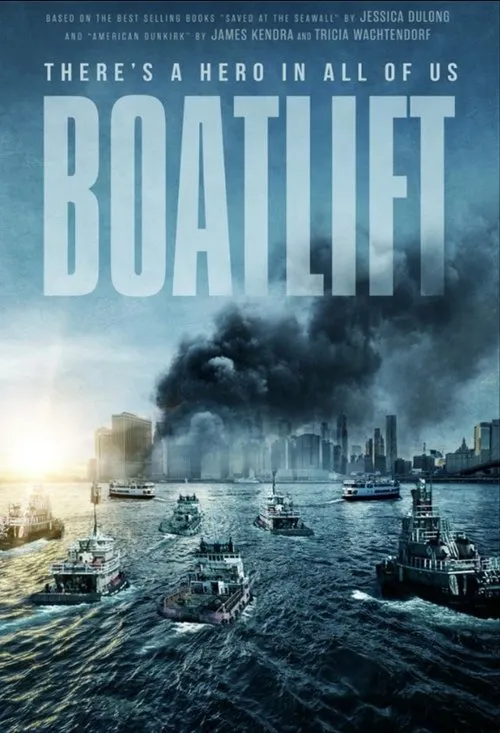Boatlift

Enredo
On that fateful morning of September 11, 2001, New York City was plunged into chaos and destruction as terrorists hijacked planes, crashing two of them into the Twin Towers of the World Trade Center. As the towers fell, a massive panic erupted, with thousands of people desperately seeking an escape from the island city. The initial response to the crisis was a stampede of people attempting to flee downtown Manhattan on foot, with many heading towards the Hudson River in hope of reaching the other side and potential safety. It soon became clear that the island was indeed surrounded by the river, with no way to easily escape by land. Faced with a daunting task, hundreds of thousands of people soon found themselves trapped on the island, with no apparent means of rescue. Amidst this chaos, a remarkable and largely unheralded story of bravery and determination emerged. The crew of the U.S.S. Intrepid, a decommissioned aircraft carrier that served as a museum ship, quickly sprang into action as soon as the towers fell. Captain Steven E. Lloyd, the ship's curator, immediately began making contact with the Coast Guard and the National Guard to discuss a potential evacuation effort. However, given the limited number of vessels available, Lloyd knew that a sea evacuation would require an unprecedented effort. It was at this point that the true heroism of the ordinary citizens of New York City, and surrounding areas, shone through. As word of the devastating attacks spread, boats of all sizes, from tugboats to ferries, private yachts to sailboats, began to converge on Manhattan's seawall. This was not a coordinated effort by a professional rescue team; instead, it was a spontaneous response by ordinary people who were driven by a desire to help. As the morning wore on, hundreds of boats gathered in Lower Manhattan, creating a temporary harbor that would become the largest sea evacuation in history. Many of the sailors, fishermen, and others who came to the aid of those trapped on the island put their own lives at risk as they battled against strong winds and rough waters. Despite the treacherous conditions, they persevered, working tirelessly to rescue as many people as possible from the stricken island. One of the most striking aspects of this incredible story is the speed and efficiency with which the impromptu evacuation effort was organized. In a matter of hours, these ordinary citizens had transformed themselves into an effective, albeit informal, rescue team. Their efforts were fueled by a sense of duty, a desire to help those in need, and a determination to overcome the unimaginable tragedy that had befallen the city. The crew of the ferries, such as the Staten Island Ferry and the Sea-Streak Ferry, played a pivotal role in evacuating thousands of people from the island. They operated in treacherous conditions, maneuvering through dense fog and navigating through debris-filled waters. Many of the ferry crew members, such as Captain John Deegan of the Sea-Streak Ferry, became unsung heroes of the day, putting their own lives on the line to bring people to safety. As the day wore on, the sea evacuation effort continued to grow in scope and scale. By the end of the day, hundreds of boats had pulled together to rescue tens of thousands of people from Manhattan, a feat that would forever be remembered as one of the greatest examples of civic duty and courage in the face of disaster. It was an outpouring of humanity, driven by a spirit of generosity and selflessness, that reflected the very best of what it means to be human. In the years that followed, the story of the sea evacuation was largely overshadowed by the massive rescue efforts that had taken place in the streets and buildings of Lower Manhattan. The Twin Towers' collapse was, undoubtedly, one of the most profound tragedies in American history. However, it is this relatively unknown story of the spontaneous sea evacuation, led by ordinary citizens who put their lives on the line to help their fellow men and women, that truly highlights the resilience and courage of the people of New York City. Directed by Eddie Rosenstein and narrated by Tom Hanks, the documentary 'Boatlift' tells this poignant and inspiring story with sensitivity, depth, and historical accuracy. By shedding light on this largely unheralded chapter in American history, 'Boatlift' serves as a poignant reminder of the strength of the human spirit in the face of adversity.
Resenhas
Recomendações


